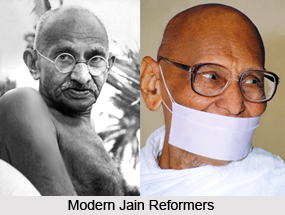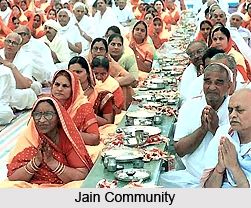 Jainism Reform Movements in Modern India are developments which took shape in the last decade of the last century. Jainas that time were asked by the organizers of the "parliament of the World-religions" to depute a .delegate to America who could represent his paternal religion. The president of the Congress had first turned to the prominent monk Atmaramji. But he was not able to accept the invitation in view of the rule of not crossing the "black water" which was observed by pious Hindus and Jaina-asceties alike. He, therefore, sent the young advocate Virachand R. Gandhi who had already made a name as a representative of his fellow-Jainas. After preparing himself for the mission under the guidance of Atmaramji, he went to Chicago where he successfully participated in the meetings of the Congress. After the end of the Congress, Gandhi visited a number of American cities, gave lectures on Jainism there and founded a "Gandhi Philosophical Society". Then he went to England, where also he organised meetings and returned to India in 1895. Gandhi`s work in England did not only awaken an interest for Jainism among the people there, but it also got followers for it.
Jainism Reform Movements in Modern India are developments which took shape in the last decade of the last century. Jainas that time were asked by the organizers of the "parliament of the World-religions" to depute a .delegate to America who could represent his paternal religion. The president of the Congress had first turned to the prominent monk Atmaramji. But he was not able to accept the invitation in view of the rule of not crossing the "black water" which was observed by pious Hindus and Jaina-asceties alike. He, therefore, sent the young advocate Virachand R. Gandhi who had already made a name as a representative of his fellow-Jainas. After preparing himself for the mission under the guidance of Atmaramji, he went to Chicago where he successfully participated in the meetings of the Congress. After the end of the Congress, Gandhi visited a number of American cities, gave lectures on Jainism there and founded a "Gandhi Philosophical Society". Then he went to England, where also he organised meetings and returned to India in 1895. Gandhi`s work in England did not only awaken an interest for Jainism among the people there, but it also got followers for it.
The Englishman Herbert Warren was won over by Gandhi for Mahavira`s religion; he published a booklet `Jainism in the Western Garb as a Solution of the great Riddle of Life` which is mainly based on Gandhi`s lectures. Warren converted few other persons to Jainism so that a "Mahavira Brotherhood" could be founded in London on August 24, 1913 with the assistance of the advocate Jagmander Lai Jaini who was in England at that time. This brotherhood was supposed to form the centre of Jainism in the West and promote Mahavira`s teachings.
 In modern India a lot of steps have been taken for the revival of Jainism in India. This is because Jainism to a large extent had lost ground in India. In the very beginning the idea of consolidating the devotees took a concrete shape among the individual creeds. Digambaras founded the "All India Digambara Jain Conference". The first conference of Swetambaras was held in Marvar in 1903 with their permanent office in Bombay (presently Mumbai). The aim of all these conferences was the same; they wanted to bring together the members of the individual creeds and unite them and to defend their faith against the onslaught of Hindus, Muslims and Christian missionaries.
In modern India a lot of steps have been taken for the revival of Jainism in India. This is because Jainism to a large extent had lost ground in India. In the very beginning the idea of consolidating the devotees took a concrete shape among the individual creeds. Digambaras founded the "All India Digambara Jain Conference". The first conference of Swetambaras was held in Marvar in 1903 with their permanent office in Bombay (presently Mumbai). The aim of all these conferences was the same; they wanted to bring together the members of the individual creeds and unite them and to defend their faith against the onslaught of Hindus, Muslims and Christian missionaries.
An inter-creed organization trying to comprise Jainas of the whole of India is an association which was founded in the year 1899 as "Jain Young Mens` Association", it assumed the name "All India Jaina Association" (Bharata Jaina Mahamandala) in 1910. Its main objective is to promote unification of all trends fighting amomg themselves and carry out reforms in a progressive spirit.
While the societies mentioned so far had far-reaching goals embracing all the branches of Jainism, others sought to restrict themselves more or less to limited field for the benefit of the whole. The societies like the "Jaina Students Association" seek to bring together the educated among Jinnas, whereas the "Jaina Ladies` Association" gets women interested in Jainism.
It can be seen that Jainas of today do not restrict their activity to working in India for their religion but also seek with the help of publications in English language in making persons not coming from India takes interest in Jainism.



















